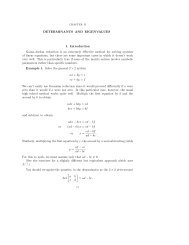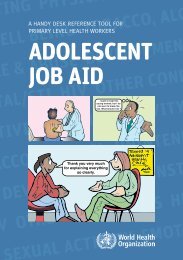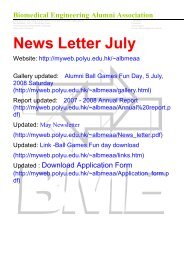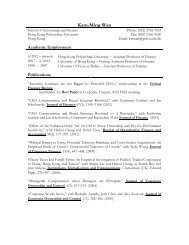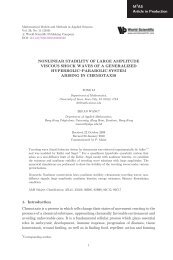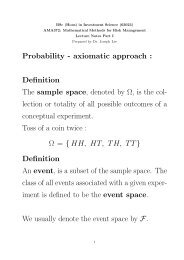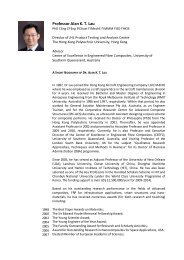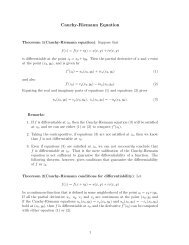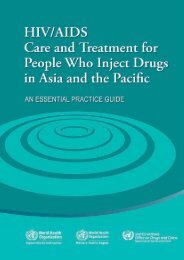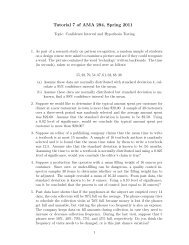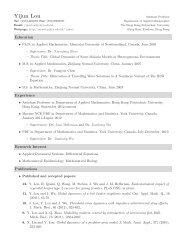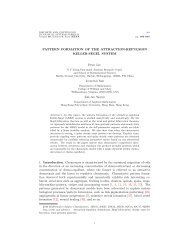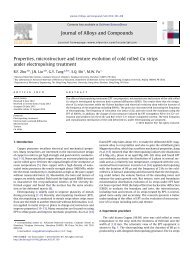Prototype expert system for site selection of a sanitary landfill
Prototype expert system for site selection of a sanitary landfill
Prototype expert system for site selection of a sanitary landfill
Create successful ePaper yourself
Turn your PDF publications into a flip-book with our unique Google optimized e-Paper software.
<strong>Prototype</strong> <strong>expert</strong> <strong>system</strong> 207placing 150–300 mm <strong>of</strong> soil over every 600 mm <strong>of</strong> compacted fill. In addition, the soil covershould have a minimum designated depth and the final cover should be grassed to preventerosion.A common projected ultimate land use <strong>of</strong> a <strong>landfill</strong> is a park with recreational facilities,which are not affected by long-term ground subsidence.Thorough investigation has to be undertaken to select the most appropriate location <strong>for</strong> a<strong>landfill</strong> <strong>site</strong>. In the <strong>site</strong> <strong>selection</strong> process, though there may exist many more factors, four mainfactors are considered, namely potential migration routes <strong>of</strong> the wastes, waste characteristics,planned features <strong>of</strong> the <strong>landfill</strong> and potential targets at risks (Noble 1976). For potentialmigration routes, the study <strong>of</strong> contaminant movement away from the disposal <strong>site</strong> throughair, surface water and ground water is focused on. The movement <strong>of</strong> wastes depends not onlyon physical, geotechnical, geographic and environmental characteristics <strong>of</strong> the <strong>site</strong> but alsoon the waste characteristics. This feature can be quantified by its toxicity, persistence, corrosiveness,reactivity, flammability, radioactivity, solubility and volatility. The planned features<strong>of</strong> the facility will affect the degree <strong>of</strong> contamination. Potential targets subsume populationcenters, critical habitats and sensitive ecological <strong>system</strong>s in its vicinity. The knowledge canbe represented to minimize or prevent a contaminant from entering into a potential migrationroute and arriving at a potential target at risk.The <strong>site</strong> <strong>selection</strong> process involves three types <strong>of</strong> factors, namely (i) physical, geographic,climatic, soil, water quality and socioeconomic conditions; (ii) political considerations, guidelines,standards and regulations established by the pertinent authorities; and (iii) <strong>expert</strong>judgment and heuristics (US Environmental Protection Agency 1984). In this process, the<strong>expert</strong> plays a key role because an enormous <strong>expert</strong> ef<strong>for</strong>t is required in the synthesis andanalysis <strong>of</strong> these components. The following tasks are also required: designing the generalscheme and a uni<strong>for</strong>m ranking procedure, identifying constraining regulations, analyzingdata and selecting a specific <strong>landfill</strong> <strong>site</strong> together with size. The judgment and <strong>expert</strong>iseemployed by <strong>expert</strong>s in solving the domain problem are then translated into a set <strong>of</strong>explicit rules.3. LandfillLANDFILL is a prototype <strong>expert</strong> <strong>system</strong> designed to provide surrogate consultation duringpreliminary hazardous waste <strong>site</strong> investigations. It provides a versatile framework <strong>for</strong> theinterpretation, classification and diagnosis <strong>of</strong> environmental conditions at waste disposal <strong>site</strong>s.The objective <strong>of</strong> such a consultation is to obtain a <strong>site</strong> rating using the <strong>expert</strong> rules and thedecision logic described in the <strong>system</strong>’s knowledge base. The ranking criteria are based on:relative risk or danger, taking into account the population at risk; the hazardous potential <strong>of</strong> thesubstances at a facility; the potential <strong>for</strong> contamination <strong>of</strong> drinking water supplies, <strong>for</strong> directhuman contact and <strong>for</strong> destruction <strong>of</strong> sensitive eco<strong>system</strong>s; and other appropriate factors.The <strong>system</strong> is compiled and encrypted to create a run-only <strong>system</strong>. This run-only <strong>system</strong> isinstalled on a microcomputer <strong>for</strong> <strong>of</strong>fice use. The user can always overrule any options andrecommendations provided by the <strong>system</strong>. However, a mechanism is built-in to ensure thatthe user’s overruled input is reasonable and consistent. In other words, it plays the role <strong>of</strong> aknowledgeable assistant only.Besides the usual components in a typical <strong>expert</strong> <strong>system</strong>, namely, knowledge base, inferencemechanism, session context, user interface, knowledge acquisition and explanation modules,it incorporates an ANN tool, fuzzy rule <strong>system</strong> and a database. The schematic diagram <strong>of</strong> thisprototype <strong>system</strong> is shown in figure 1.




